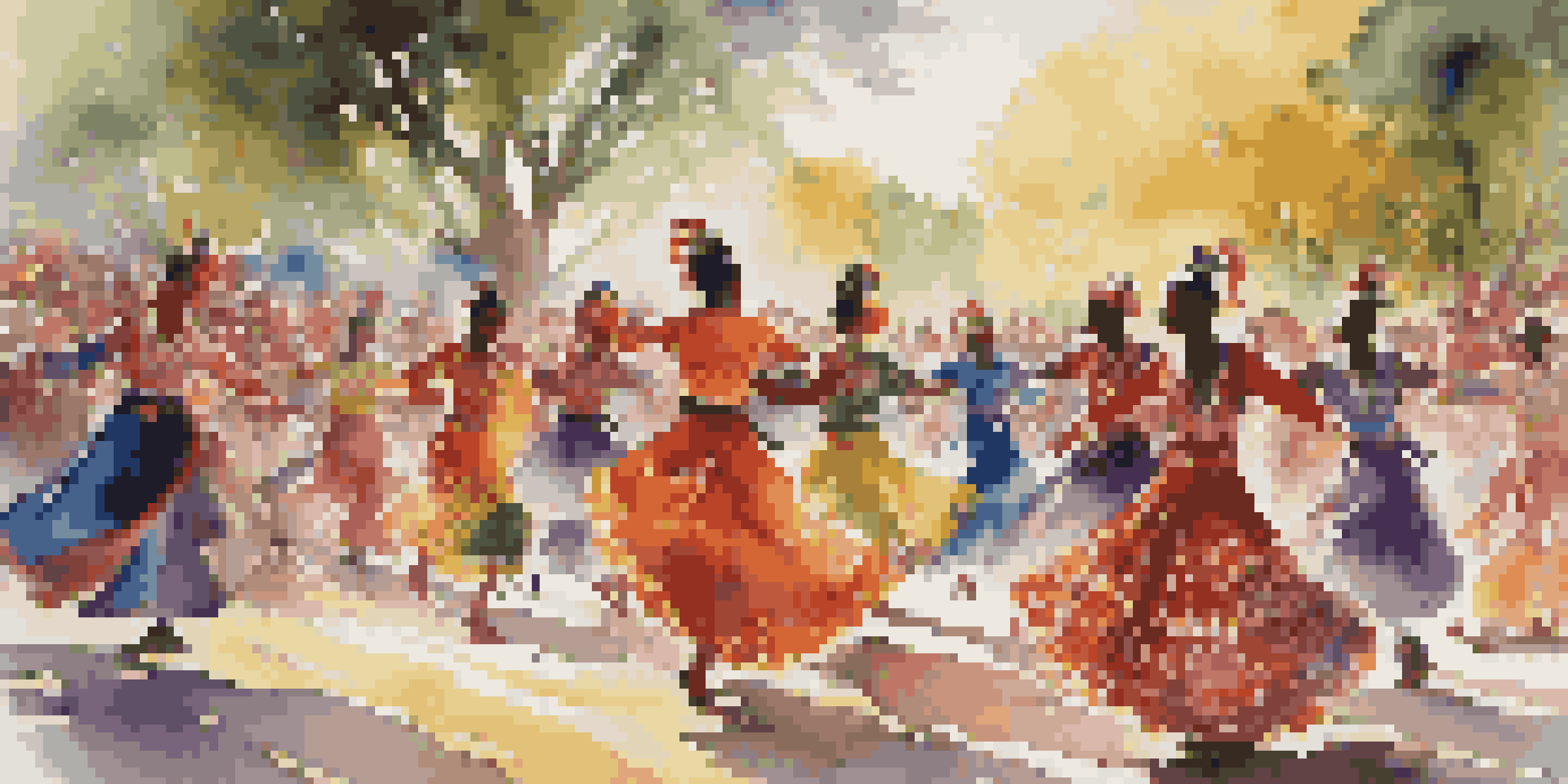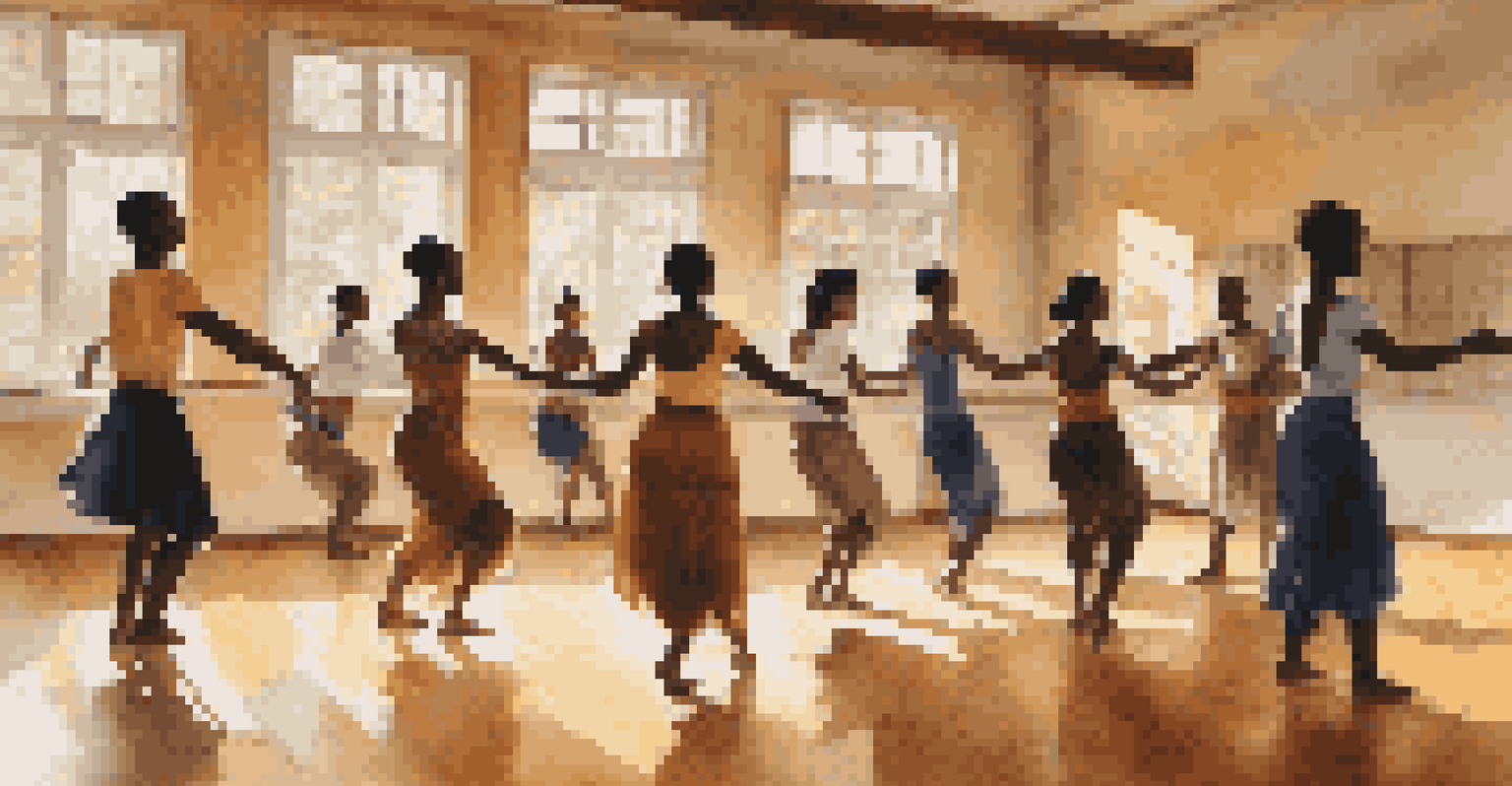The Role of Dance in Shaping Public Perception of Cultures

Dance as a Reflection of Cultural Identity
Dance is often a vibrant expression of cultural identity, showcasing the unique traditions and values of communities. Through intricate movements and rhythms, it tells stories that words sometimes cannot convey. For instance, traditional ballet reflects European history and aesthetics, while African dance often emphasizes communal ties and spiritual connections.
Dance is the hidden language of the soul.
When people engage with these dances, they glimpse the essence of the culture, fostering a deeper appreciation. This connection can lead to curiosity and respect, breaking down barriers of misunderstanding. As audiences witness performances, they may find themselves drawn into the world of the dancers, experiencing a shared humanity that transcends differences.
Thus, dance serves as a powerful medium, allowing cultures to express their identities in ways that resonate with wider audiences. It not only entertains but educates, inviting people to explore diverse cultural landscapes through the universal language of movement.
How Dance Shapes Global Perceptions
In our interconnected world, dance has the ability to shape global perceptions of cultures. Popular dance forms, like hip-hop or salsa, often emerge from specific cultural roots but gain international appeal, leading to a blend of influences. This fusion can sometimes alter the original meanings, creating new interpretations that may or may not align with the culture's intent.

For instance, while hip-hop originated as a voice for marginalized communities, its global popularity has led to commercial interpretations that may overlook its historical context. This can lead to misunderstandings, as audiences may perceive the dance without its rich background. It’s essential to recognize these origins to truly appreciate the art form and the culture it represents.
Dance Reflects Cultural Identity
Dance serves as a vibrant expression of cultural identity, showcasing unique traditions and values through movement and rhythm.
Ultimately, dance becomes a double-edged sword; it can promote cultural appreciation but also risk commodification. By understanding the roots of these dances, we can better navigate their global impact and ensure that we honor the cultures they represent.
Dance in Cultural Diplomacy and Exchange
Dance also plays a significant role in cultural diplomacy, where nations use it as a tool for fostering relationships. Cultural exchange programs often include dance performances, allowing artists to share their heritage while creating a platform for dialogue. This exchange not only enriches the understanding of different cultures but also highlights the commonalities that unite us.
The dance is a poem of which each movement is a word.
For example, international dance festivals often feature a variety of styles, from classical Indian Bharatanatyam to Brazilian Samba, showcasing the diverse tapestry of global dance. Such events encourage collaboration among artists from different backgrounds, cultivating mutual respect and understanding. This creates a space where cultural narratives can be shared and appreciated.
As dance transcends borders, it becomes a bridge for cultural exchange, fostering goodwill and breaking down stereotypes. Through shared experiences and performances, nations can come together, celebrating both their differences and shared humanity.
The Role of Social Media in Dance and Culture
In today's digital age, social media is a powerful platform for sharing dance and cultural narratives. With just a few clicks, users can discover dance styles from around the world, leading to a greater appreciation for diverse cultures. Viral dance challenges on platforms like TikTok often introduce traditional dance forms to new audiences, sparking interest and curiosity.
However, this exposure comes with challenges. While social media can elevate lesser-known dances, it can also lead to appropriation, where elements of a culture are used without understanding their significance. This highlights the importance of educating audiences about the origins and meanings behind the dances they see online.
Social Media's Role in Dance
Social media platforms facilitate the sharing of diverse dance forms, but also pose challenges related to cultural appropriation and understanding.
As we navigate this digital landscape, it's crucial to engage with dance in a thoughtful manner. By supporting and respecting the cultures from which these dances originate, we can ensure that social media serves as a positive force for cultural understanding and appreciation.
Dance in Education and Cultural Awareness
Incorporating dance into educational curricula can significantly enhance cultural awareness. Schools that offer dance programs expose students to various cultural backgrounds, fostering an appreciation for diversity from a young age. This experiential learning allows students to understand the history and significance behind each dance form, enriching their overall educational experience.
For instance, a class on African dance might not only teach movements but also discuss the cultural rituals and community bonds that the dance embodies. Such holistic education promotes empathy and respect among students, equipping them with a broader worldview. This understanding can combat stereotypes and encourage more inclusive attitudes.
By valuing dance as an educational tool, we can cultivate future generations that appreciate cultural diversity. This lays the groundwork for a more harmonious society, where differences are celebrated rather than feared.
Challenging Stereotypes Through Dance
Dance has the potential to challenge stereotypes and reshape public perceptions of cultures. By showcasing authentic representations of cultural dances, performers can break down preconceived notions that often accompany certain ethnicities. For example, contemporary dance companies that incorporate traditional elements can provide fresh perspectives on cultural narratives.
When artists push the boundaries of their dance forms, they invite audiences to reconsider what they thought they knew. This not only highlights the diversity within cultures but also encourages dialogue about broader societal issues. Through dance, artists can address themes such as identity, migration, and resilience, fostering deeper connections with audiences.
Dance as a Tool for Education
Incorporating dance into education promotes cultural awareness and empathy, enriching students' understanding of global diversity.
Ultimately, by challenging stereotypes through dance, we can cultivate a more nuanced understanding of different cultures. This shift in perception can lead to greater empathy and appreciation, promoting a more inclusive world.
The Future of Dance and Cultural Perception
As we look to the future, the role of dance in shaping cultural perception will likely evolve alongside societal changes. With advancements in technology and globalization, we can expect to see even greater fusion of dance styles and cultural narratives. This dynamism will continue to enrich our understanding of different cultures, while also posing new challenges.
It is vital for artists, educators, and audiences alike to engage with dance mindfully, respecting its roots while exploring new interpretations. As we embrace the evolution of dance, we must also commit to preserving its cultural significance. This balance will be crucial in ensuring that dance remains a true representation of its origins.

In navigating this evolving landscape, we can harness the power of dance to foster cross-cultural dialogue and understanding. Embracing the future of dance means celebrating the richness of cultural diversity while remaining grounded in the stories that brought these art forms to life.